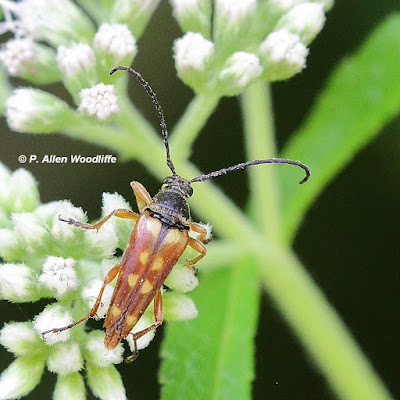The challenge is to see the myriad creatures and photograph them so that they can be identified. Some are fairly large and obvious, while others are so small you hardly can see them even when you are looking at them, and they don't really show their spectacular selves until you are able to enlarge them on the computer!
Bees, of course, are welcome pollinators. There are many kinds which show up on their own schedule over the course of the season. This first one is called a type of Cuckoo Bee.
I haven't figured out exactly what this next one is. I've even posted it on the BugGuide site, and no one has responded yet.
This next one is the Pruinose Squash Bee. The males especially are often found in the flowers of members of the squash family. They will often spend the night inside the flowers, and apparently if you gently squeeze the flower early in the morning, the bees inside will give a buzzing sound that presumably is meant to say something like 'don't disturb me, I'm trying to sleep'
A large and intimidating member of the bee and wasp family is this next one: the Great Black Wasp. It's body is ~5 cm (2") and its quick darting flight makes one cautious. However it is apparently quite harmless unless you handle it. I've never been bothered by any bee/wasp types even when sticking my camera lens within a few centimetres of their face.
There are some bee look-alikes, such as this Syrphid Fly.One creature you don't want to see, especially if you are trying to grow squash or zucchini, is this next one, the Squash Bug.
It lays clusters of eggs on the underside of the leaves, and when the larvae emerge, they dig into the plant stems, causing the plant to wither and die.
Fortunately if you have this next one around, the Feather-legged Fly, it is a predator of the Squash Bug, so it may reduce the negative effects of the Squash Bug.
Beetles abound. These next two images are of the Wedge-shaped Beetle.
The antennae of this male in the next photo is pretty impressive!
Some look-alikes include the Goldenrod Soldier Beetle, shown in these next two images.
Sometimes you may see a caterpillar like creature. It is likely the larva of a beetle of some type.
The Swamp Milkweed Beetle is often found on any kind of milkweed in the garden.
Plant 'bugs' are different than beetles, since their wings fold and overlap. These next two bugs are members of the plant bug group, probably in the Lygus genus.
Flies of various kinds are around, some of which are pollinators. This one is a Tachinid fly.
A very large one is this Robber Fly.
At the other end of the size scale is this Long-legged Fly, a very shiny and iridescent but very small fly.
Grasshoppers of different sizes and colours can be found. These next two are very small, barely 4-5 cm in total length. Since grasshoppers develop from egg to nymph to adult, it is likely these may be nymphs (a small version of an adult)
If you happen to be a bug crawling around on a flower head, you have to be on the lookout for this next creature. It is an Ambush Bug, and although it is small (barely 2-3 cm) it is quite the predator.
Day flying moths may show up. This one is quite distinctive, known as the Eight-spotted Forester.
A caterpillar that is often found around milkweeds is this Milkweed Tussock Caterpillar. A group of them can eat a lot of milkweed leaves in a short period of time.
One of the tiniest creatures I've been able to photograph is this leafhopper, of the Scaphytopius genus. It is barely two millimetres in total length!
The garden is a never ending source of fun to explore with a camera and macro lens!


































































